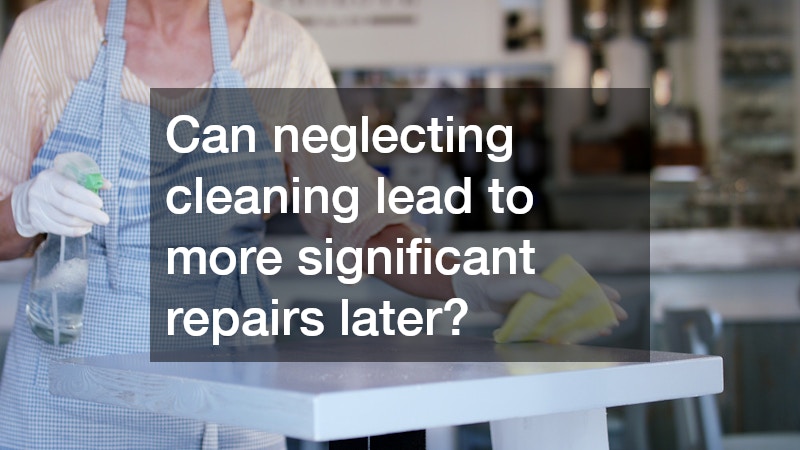Cleaning is often seen as a mundane task, but its role in maintaining a well-functioning home or business cannot be overstated. Regular cleaning routines not only keep spaces tidy but also play a crucial role in identifying minor repair needs before they escalate into major issues. By emphasizing the importance of cleaning, we can foster a proactive approach to maintenance that will save both time and money in the long run.
How does cleaning help in identifying issues?

The thoroughness of cleaning
Cleaning with intention and thoroughness allows for a detailed inspection of surfaces and structures. When surfaces are wiped down and clutter is removed, hidden damage becomes visible, making it easier to notice areas that require attention. Therefore, when we engage in comprehensive cleaning, we’re not just making our spaces look good, but we are actively seeking out potential repair needs.
Impact of dirt and grime on visibility
Dirt and grime can obscure signs of damage that might otherwise be obvious. Mold, rust, and leaks can be easily overlooked in a dirty environment, adding to the risk of severe damage over time. Thus, cleaning acts as a revealing process, uncovering issues that need addressing through regular upkeep.
Observational awareness during cleaning
During cleaning, individuals become more attuned to their surroundings, which enhances observational skills. This awareness can lead to the discovery of worn-out fixtures, peeling paint, or signs of wear on countertops that may have otherwise gone unnoticed. Taking time to clean mindfully fosters a greater appreciation for the state of one’s environment, encouraging preventive maintenance.
What types of repairs are commonly discovered during cleaning?
Surface damage
Surface damage, such as scratches or dents on countertops and flooring, often comes to light during cleaning. These imperfections, if ignored, can develop into more significant problems that affect the overall aesthetic and function of your spaces. Regularly cleaning surfaces not only keeps them looking their best but also allows for timely repairs to be made before they worsen. Noticing small chips, stains, or cracks early means you can address them with minor repairs instead of costly replacements later. Consistent upkeep also helps you track wear and tear over time, giving you better control over your home’s condition.
Plumbing leaks
Cleaning areas like bathrooms and kitchens can quickly reveal plumbing leaks or issues with water fixtures. Observing dripping taps during routine cleaning can prompt immediate action to call a local plumber before water damage ensues. Being proactive about these findings can prevent costly repairs down the line.
Electrical problems
Cleaning can also shed light on potential electrical issues, such as burnt outlet covers or frayed cords. It’s crucial to check these areas during cleaning routines, as neglecting them can lead to severe hazards like electrical fires. Thus, integrating electrical checks into the cleaning process is an essential part of home maintenance.
How often should we clean to reveal these minor repairs?
Weekly cleanings vs. deep cleanings
Weekly cleaning routines are essential for maintaining a clean home and should focus on high-traffic areas and frequently used spaces. Deep cleaning, which might be scheduled monthly or quarterly, allows for more thorough inspections of all areas, revealing those minor repair needs. Both types of cleaning play important roles in keeping a home or business in optimal condition.
Seasonal cleaning schedules
Seasonal cleaning schedules are beneficial for addressing specific tasks that accumulate over time, such as pressure washing outside or in-depth kitchen appliance cleaning. Pressure washing companies can help with that, especially in the spring and summer. Different seasons present unique maintenance tasks that can reveal minor repairs necessary for the upcoming months. For example, checking for leaks before winter can stave off the more significant damage caused by frozen pipes.
Maintenance check-ups
In addition to regular cleaning, scheduling maintenance check-ups can serve as a critical supplement to your cleaning routines. These check-ups might include professional drain cleaning, HVAC servicing, and inspections that catch issues early before they escalate. When combined with a thorough cleaning regimen, these proactive practices help ensure homes remain functional, safe, and stress-free year-round.
What specific areas should be prioritized during cleaning?

Kitchen appliances and fixtures
The kitchen is the heart of the home, and cleaning this area should take priority when assessing repairs. Regularly inspecting appliances and fixtures for build-up or damage can reveal potential issues like faulty wiring or leaks. By focusing on the kitchen, homeowners can detect minor repair needs before they escalate into costly problems.
Bathroom plumbing and tiling
Bathrooms are notorious for minor repair needs, from tile grouting problems to plumbing leaks. Regular cleaning and maintenance can reveal cracks and discoloration in shower glass and other fixtures that need attention. Addressing these issues promptly can help maintain the integrity of the space and avoid costly renovations.
Living spaces and exterior doors
Living spaces often harbor dust and other harm-causing agents that can lead to decoration and structural issues. Regularly assessing and cleaning areas behind furniture or along baseboards can help uncover minor repairs. Additionally, checking exterior doors for wear and tear can prevent security concerns and weather damage.
How can cleaning methods influence repair detection?
Use of tools and equipment
The right cleaning tools and equipment can facilitate a more detailed inspection of your home. For instance, using a steam cleaner can help sanitize surfaces while revealing potential issues like water damage in carpets. Conversely, using inadequate tools may not allow for thorough inspection, which could overlook minor repairs.
Cleaning solutions and their effectiveness
The cleaning solutions used can significantly affect the efficacy of the cleaning process and repair detection. Non-toxic and effective cleaning agents can help spot differences in surfaces and odors that may suggest underlying damage. Choosing the right solutions ensures a safe and effective cleaning process that doesn’t mask minor repairs that need attention.
The role of professionals vs. DIY cleaning
While DIY cleaning is valuable, hiring professionals when necessary can guarantee a thorough job from a knowledgeable perspective. Professionals not only bring expertise in cleaning but can also identify minor repairs due to their trained eyes. Utilizing local cleaning services as part of your maintenance routine can lead to a better understanding of your repair needs.
What are the psychological benefits of cleaning beyond repairs?
Increased mindfulness
Engaging in cleaning fosters increased mindfulness, as individuals focus on the task at hand rather than distracting thoughts. This awareness can extend beyond the cleaning itself, leading to greater appreciation for one’s living environment. In turn, this mindfulness can contribute to emotional well-being, creating a more pleasant space.
Stress reduction
Cleaning can act as a therapeutic activity that helps reduce stress. The act of organizing and refreshing one’s environment often leads to a sense of accomplishment and control over one’s surroundings. This emotional relief can be magnified when cleaning also uncovers and addresses minor repair needs, allowing for a holistic improvement in one’s space. Nothing beats the feeling of relief when you see local curbside trash pickup getting rid of your mess.
Motivation to maintain the environment
Having a clean environment encourages ongoing maintenance and reinforces a habit of regular cleaning. This proactive approach can prevent the accumulation of dirt and grime, ensuring that minor repair needs are identified before they escalate. This motivation fosters a lifestyle of care and attention toward one’s space, creating an ongoing cycle of maintenance and improvement.
Can neglecting cleaning lead to more significant repairs later?

Accumulation of damage
Neglecting cleaning can lead to an accumulation of damage that goes unnoticed until it becomes a substantial problem. For instance, continuous dirt accumulation can cause surfaces to wear down more quickly than they otherwise would. This neglect may ultimately result in unforeseen repairs that could have easily been caught through regular cleaning.
Pest problems emerging from dirt
A dirty environment is inviting to pests, leading to infestations that can cause significant damage and health concerns. Regular cleaning not only addresses visible issues but also ensures that food particles and hiding spaces for pests are minimized. By neglecting cleaning, homeowners may find themselves facing pest problems that require invasive solutions, such as calling a disposal service.
Delayed identification of major issues
Failing to maintain a regular cleaning routine often leads to the delayed identification of essential repairs. Mold growth, plumbing leaks, and other significant issues can develop quietly and without notice in neglected areas, resulting in higher repair costs. Timely cleaning and maintenance practices can prevent these preventable and costly repairs from arising.
What role does regular maintenance play in preventing repairs?
Scheduled inspections
Integrating scheduled inspections into your maintenance routine is crucial for early detection of repair needs. These inspections should coincide with regular cleaning sessions to enhance the identification process. Professional services, such as drain cleaning or plumbing inspections, should be part of this plan to ensure issues are prevented before they develop.
Regular cleaning routines
Regular cleaning routines help keep spaces in optimal condition and prevent wear and tear from accumulating over time. Constant engagement with your home or business environment will not only make you more aware of your surroundings but will also create a habit of maintaining your property. This proactive approach can lead to immediate action on repairs, significantly reducing costs in the long run.
Creating a proactive maintenance plan
A well-thought-out maintenance plan outlines the cleaning and repair needs of a space, establishing routines and schedules that prioritize regular upkeep. By creating a documented plan, individuals can ensure that cleaning and inspections happen consistently, addressing minor repairs as they arise. This proactive strategy fosters a sense of ownership and responsibility for the environment, encouraging healthier spaces.
How can technology aid in cleaning and repairs?
Smart cleaning devices
Technological advancements have made it easier to incorporate smart cleaning devices into our routines. Devices like robotic vacuums can provide an additional layer of cleaning while giving individuals more time to focus on inspections. These smart solutions can enhance the cleaning process, leading to better repair detection by maintaining a clean environment with less effort.
Apps for maintenance tracking
Mobile applications that help track maintenance schedules and cleaning routines can bring greater organization to home care. These apps remind users of what cleaning tasks need attention and when to schedule professional services, such as local trash removals, like local curbside trash pickup, or carpet cleaning. Such technology can optimize the care of your environment, ensuring that no minor repairs are overlooked.
Visual inspection technology
New technologies, like thermal imaging and moisture detection devices, offer innovative ways to identify minor repairs. These methods allow homeowners to glimpse behind walls, detecting issues like insulation failure or plumbing leaks that the eye might miss during standard cleaning. Utilizing visual inspection technology not only enhances repair detection but can also save significant costs on extensive repair jobs.
What are the best practices for staying organized during cleaning?

Decluttering before cleaning
Decluttering before cleaning is an essential first step that facilitates a more thorough and efficient process. By removing excess items from spaces, individuals can easily access the areas that require cleaning and inspection. This practice also minimizes distractions, allowing for greater focus on identifying minor repairs. You might want to look into storage container solutions, like redesigning a few closets to make them more holiday, craft, and seasonal-friendly.
Creating a checklist
Creating a checklist serves as a valuable tool to ensure that all cleaning tasks and inspections are accounted for. This methodical approach can help prevent missed areas, making the cleaning process both efficient and thorough. Additionally, having a checklist promotes accountability, ensuring individuals stay on track with their maintenance goals.
Rewarding yourself for completed tasks
Incorporating a rewarding system for completed cleaning tasks can increase motivation and enjoyment in maintaining your space. Rewards could range from treating yourself to a favorite snack after a thorough cleaning session to enjoying time in your freshly refreshed environment. These small incentives can create a positive association with the cleaning process, fostering a commitment to regular maintenance and repair detection.
Conclusion
In summary, cleaning is a vital practice that not only maintains appearances but also reveals minor repair needs critical for preserving homes and businesses. Through routine cleaning, inspections, and attention to detail, individuals can proactively address issues before they become significant problems. By fostering a culture of regular maintenance, we can enjoy cleaner environments, reduced stress, and improved overall health and safety in our spaces.

